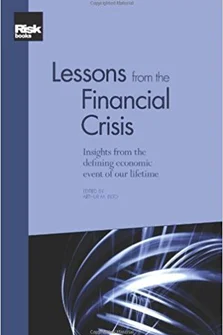The Endogenous Dynamics of Markets: Price Impact, Feedback Loops and Instabilities
Introduction to 'Lessons from the Financial Crisis'
The Credit Crunch of 2007: What Went Wrong? Why? What Lessons Can be Learned?
Underwriting versus Economy: A New Approach to Decomposing Mortgage Losses
The Shadow Banking System and Hyman Minsky’s Economic Journey
The Collapse of the Icelandic Banking System
The Quant Crunch Experience and the Future of Quantitative Investing
No Margin for Error: The Impact of the Credit Crisis on Derivatives Markets
The Re-Emergence of Distressed Exchanges in Corporate Restructurings
Modelling Systemic and Sovereign Risks
Measuring and Managing Risk in Innovative Financial Instruments
Forecasting Extreme Risk of Equity Portfolios with Fundamental Factors
Limits of Implied Credit Correlation Metrics Before and During the Crisis
Another view on the pricing of MBSs, CMOs and CDOs of ABS
Pricing of Credit Derivatives with and without Counterparty and Collateral Adjustments
A Practical Guide to Monte Carlo CVA
The Endogenous Dynamics of Markets: Price Impact, Feedback Loops and Instabilities
Market Panics: Correlation Dynamics, Dispersion and Tails
Financial Complexity and Systemic Stability in Trading Markets
The Martingale Theory of Bubbles: Implications for the Valuation of Derivatives and Detecting Bubbles
Managing through a Crisis: Practical Insights and Lessons Learned for Quantitatively Managed Equity Portfolios
Active Risk Management: A Credit Investor’s Perspective
Investment Strategy Returns: Volatility, Asymmetry, Fat Tails and the Nature of Alpha
Why do asset prices move so frequently and why is the volatility so high? Why do prices move at all? These are obviously fundamental questions in theoretical economics and quantitative finance, which encompass other, related issues: what is the information reflected by prices, and to what extent market prices reflect the underlying economic reality? Do we understand the origin of crises and crashes?
In this chapter, we review the evidence that the erratic dynamics of markets is to a large extent of endogenous origin, ie, determined by the trading activity itself and not due to the rational processing of exogenous news. In order to understand why and how prices move, the joint fluctuations of order flow and liquidity, and the way in which these impact on prices, become the key ingredients. Impact is necessary for private information to be reflected in prices but, by the same token, random fluctuations in order flow necessarily contribute to the volatility of markets. Our thesis is that the latter contribution is in fact dominant, resulting in a decoupling between prices and fundamental values, at least on short-to-medium timescales. We argue that markets operate in a regime of
Copyright Infopro Digital Limited. All rights reserved.
As outlined in our terms and conditions, https://www.infopro-digital.com/terms-and-conditions/subscriptions/ (point 2.4), printing is limited to a single copy.
If you would like to purchase additional rights please email info@risk.net
Copyright Infopro Digital Limited. All rights reserved.
You may share this content using our article tools. As outlined in our terms and conditions, https://www.infopro-digital.com/terms-and-conditions/subscriptions/ (clause 2.4), an Authorised User may only make one copy of the materials for their own personal use. You must also comply with the restrictions in clause 2.5.
If you would like to purchase additional rights please email info@risk.net










